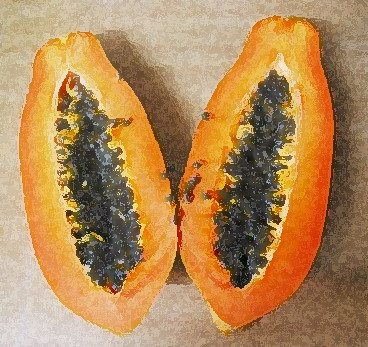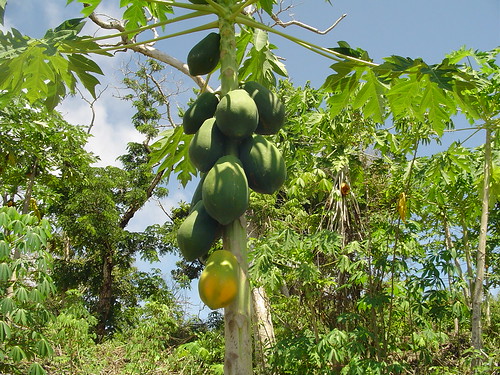
Papaya – Root and Branch Review
The Papaya is a widely grown fruit tree of the tropics. It’s large fleshy fruit contains many seeds but can weigh from 1 pound up to 20 pound on some varieties.
Key Features of the Papaya
- Latin name – Carica Papaya – other common names Papaw, or Pawpaw or Mugua
- Height – up to 33 feet
- Type of tree – evergreen
- Leaves – Long deeply lobed dark green and alternate
- Flowers – Males and females on separate trees with yellow or pink petals
- Fruit – Large, ovoid, fleshy fruit up to 12″ long. Orange or pink flesh surrounding multiple soft black seeds
- Bark – Light brown with leaf scars
- Family – The only member of the Carica genus
Origins and Distribution of the Papaya
- Widely grown throughout the tropics.
- Originally native to Mexico and central America.
Uses and Attributes of the Papaya
- The fruit contains many vitimins and trace chemicals. The latex and leaves can be made into drinks and there are many medical uses for the Papaya.
- Ripe fruit with sweet, yellow or pink flesh make a traditional tropical breakfast.
- The raw fruit and the leaves contain an enzyme, papain, that is used to tenderise meat.
- Green unripe Papaya are used in several folk remedies and for both contraception and abortion.
- The bark can be used to make rope.
Gardeners Tips for the Papaya
- Another tree to leave for the hotter (and wetter) climates.
Other Types of Papaya
- There are many varieties available. Some have small pear shaped fruit others have large round heavy pawpaws.
- One type has sweet, red and the other has yellow flesh not surprisingly called “red papaya” and “yellow papaw”, respectively. Either kind, picked green, is called a “green papaya.”
- Large-fruited, red-fleshed varieties include ‘Maradol’, ‘Sunrise’, and ‘Caribbean Red’.
- There are a growing number of genetically modified species including ‘SunUp’ and ‘Rainbow’,
- Generally Hawaiian variety are smaller and pear-shaped, while Caribbean and Asian papayas are long and large.
- Confusion exists with the Custard Apple family of Asimina triloba and Asimina tetramera, commonly known as the four-petal pawpaw in some countries.
Papaya comments from elsewhere
- ‘Deliciously sweet with musky undertones and a soft, butter-like consistency, it is no wonder the papaya was reputably called the “fruit of the angels” by Christopher Columbus. Once considered quite exotic, they can now be found in markets throughout the year. Although there is a slight seasonal peak in early summer and fall, papaya trees produce fruit year round’. for more on health benefits .
Credits
Papaya by enbodenumer CC BY-NC-SA 2.0
papaya by mars! CC BY-NC-SA 2.0
Papaya by mwanasimba CC BY-SA 2.0


